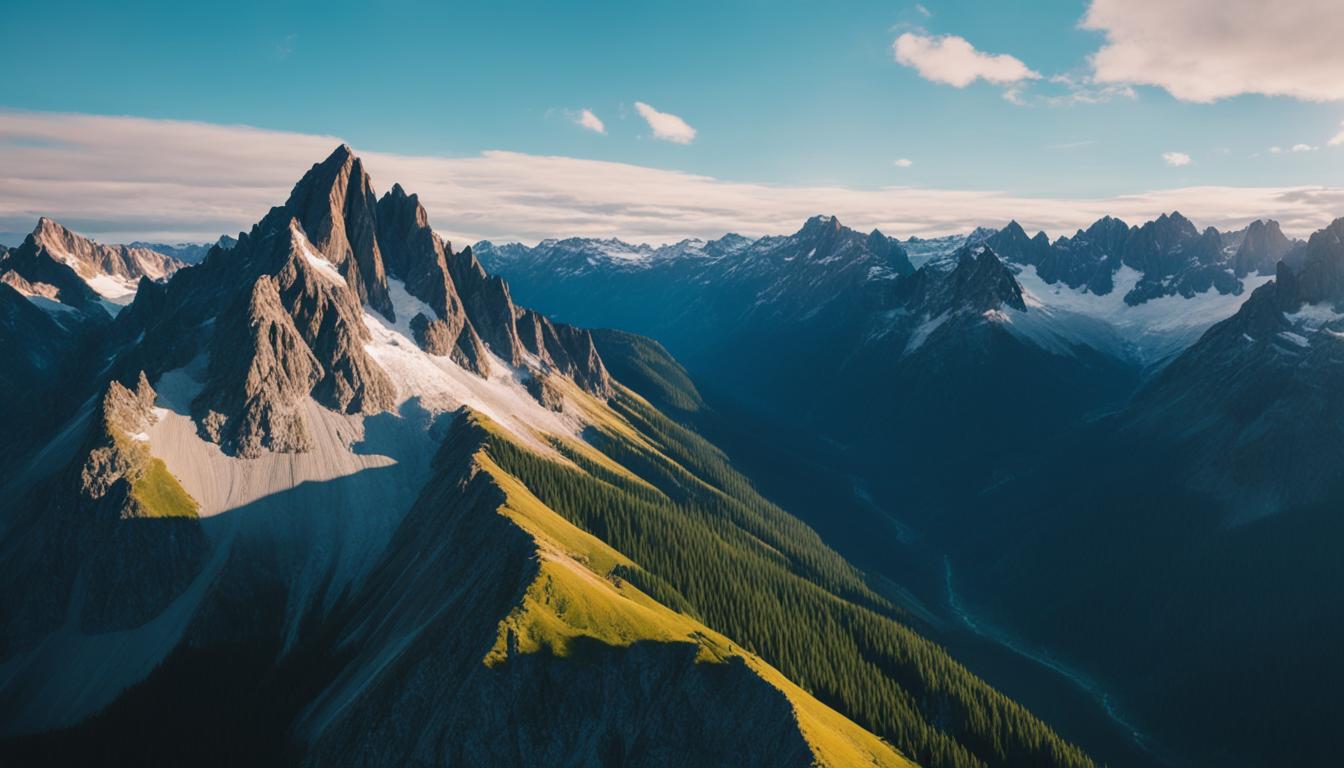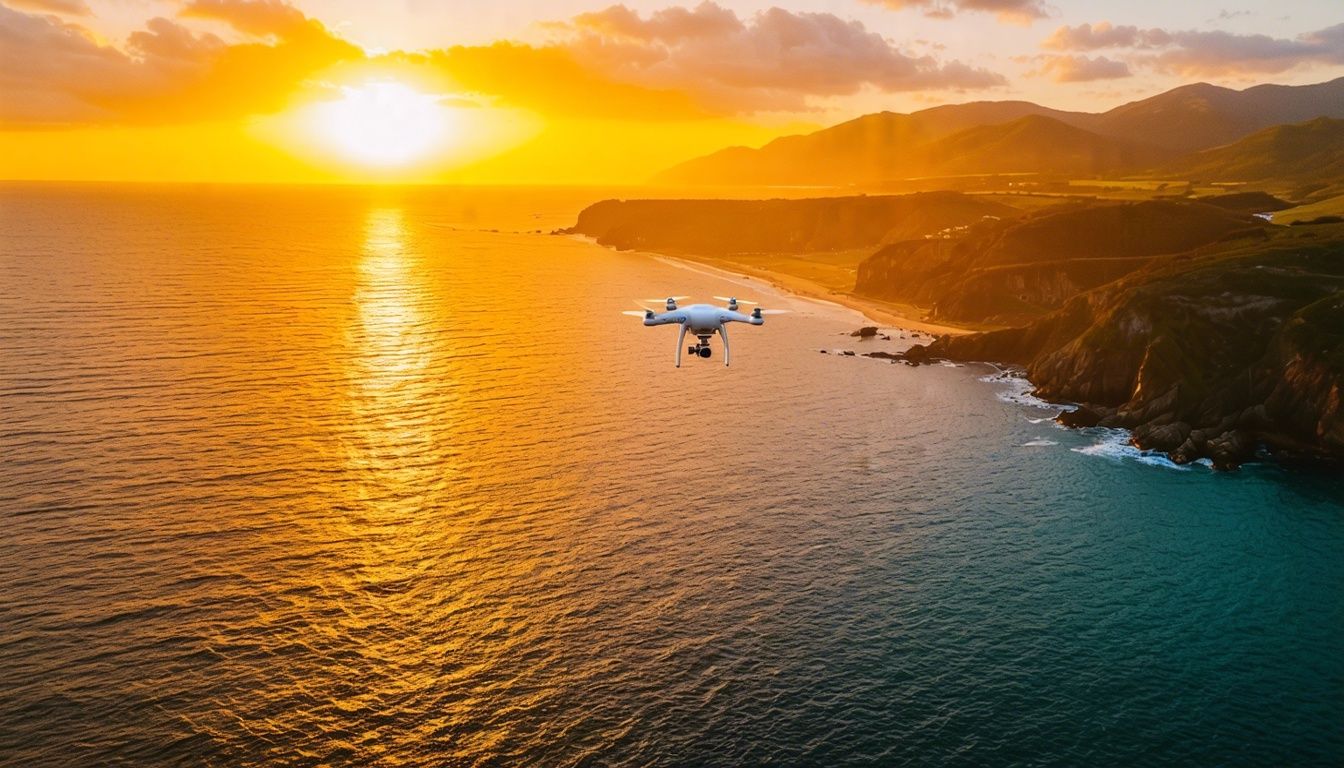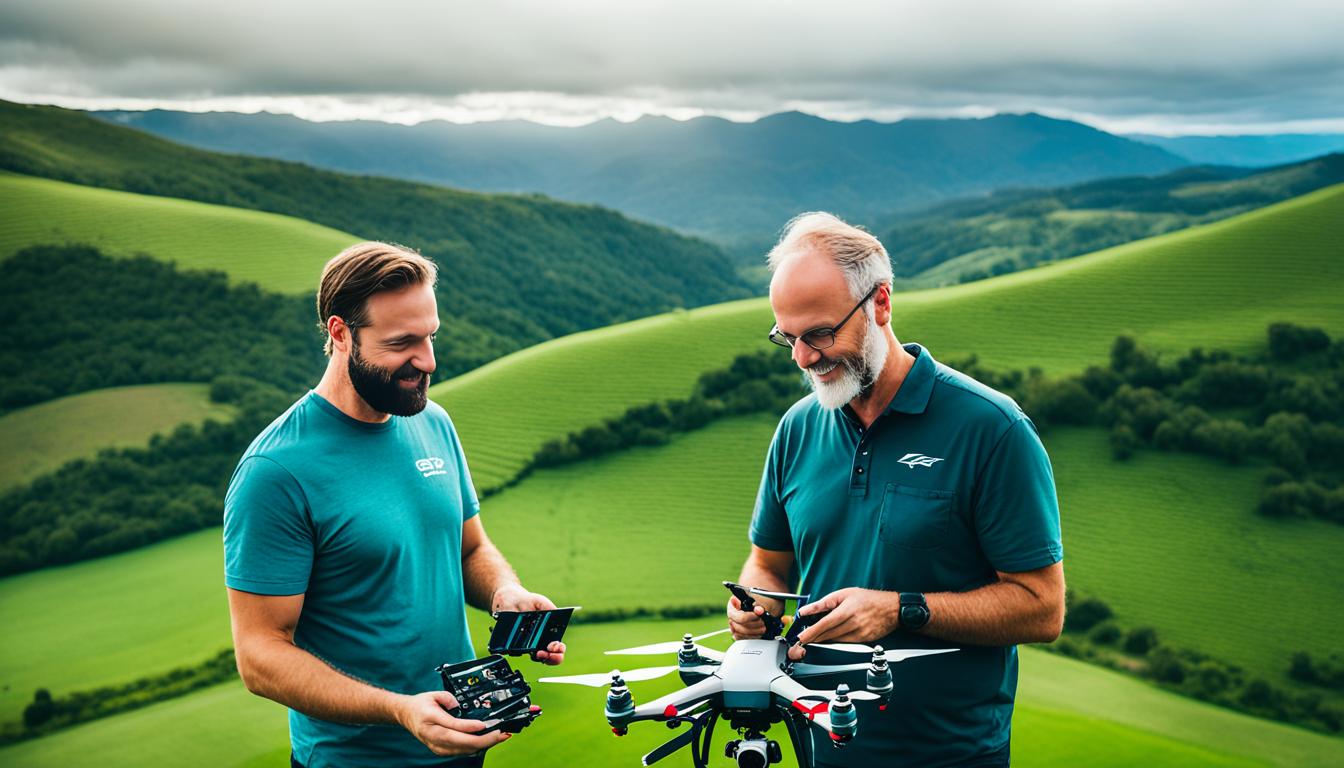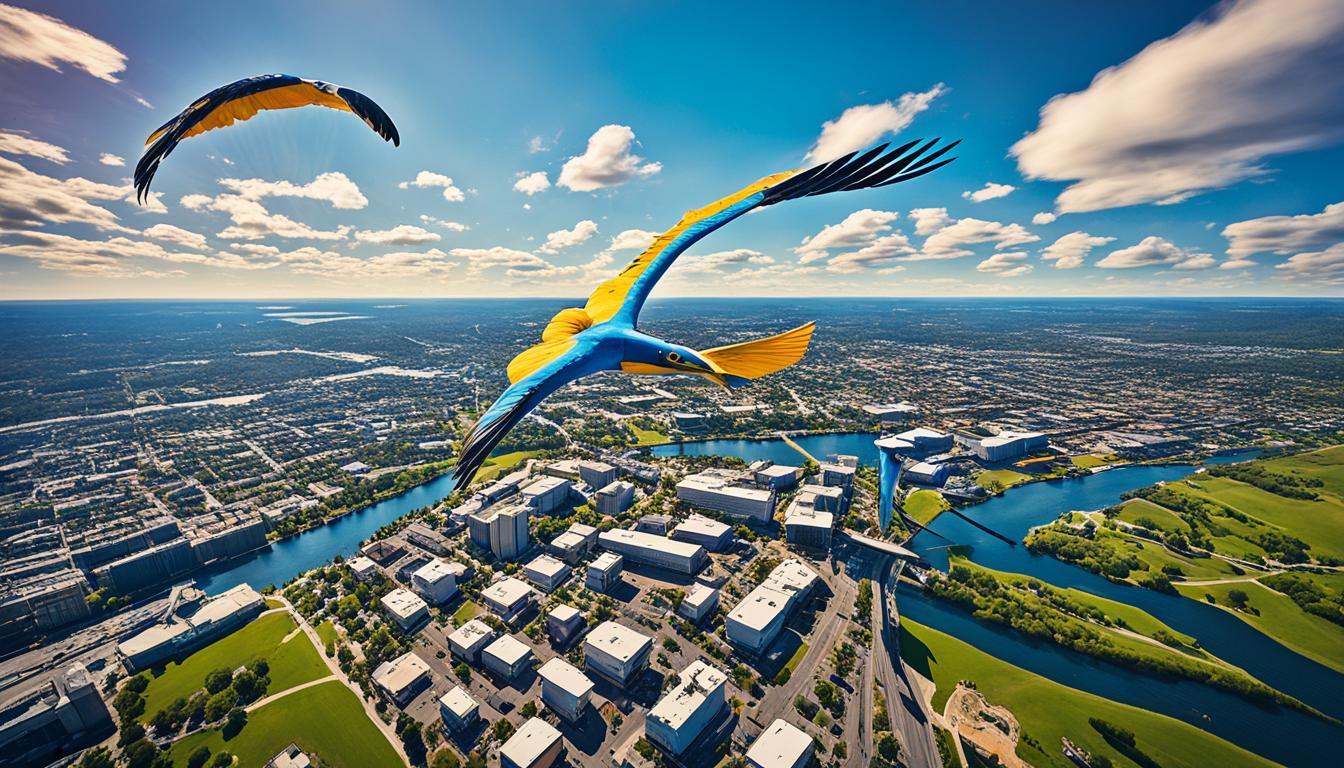Drone photography has revolutionized the world of landscape photography, allowing photographers to capture breathtaking aerial views and explore unique angles that were once inaccessible. Whether you’re a seasoned pro or just starting out, this comprehensive guide will equip you with the essential knowledge and expert tips to elevate your landscape photography with drones.
Key Takeaways:
- Drone photography provides a unique perspective and allows for capturing stunning aerial views.
- Mastering the art of landscape photography with drones requires understanding drone camera settings and techniques.
- Choosing the right drone with advanced features and image quality is crucial for producing professional results.
- Experimenting with different angles, heights, and compositions can lead to more visually compelling images.
- Post-processing techniques, such as shooting in RAW format and adjusting exposure, enhance the overall quality of drone images.
The Basics of Drone Photography
Drone photography is an exciting and innovative way to capture stunning still images and videos. By utilizing a remotely-operated or autonomous unmanned aerial vehicle (UAV), photographers can explore unique angles and heights, unlocking limitless creativity and visual storytelling. The art of drone photography requires a combination of technical skills, effective camera settings, and high-quality equipment.
Drone Photography Techniques
Mastering drone photography techniques is essential for capturing breathtaking landscapes. Here are a few tips to enhance your skills:
- Practice controlling your drone: Familiarize yourself with the drone’s controls and flight capabilities to maneuver smoothly in various conditions.
- Perfect your framing: Experiment with different angles, perspectives, and compositions to capture compelling images.
- Utilize movement: Explore different flight paths, speeds, and rotations to add dynamism to your shots.
- Adjust camera settings: Optimize camera settings such as ISO, shutter speed, and aperture to suit the lighting and landscape.
By incorporating these techniques into your drone photography, you can capture stunning visuals that resonate with viewers.
Drone Camera Settings for Landscapes
The right camera settings are crucial for capturing the beauty of landscapes. Here are some recommended drone camera settings:
| Camera Setting | Recommended Value |
|---|---|
| ISO | Low to minimize noise and maintain image quality |
| Shutter Speed | Relative to the movement in the scene; faster for fast-moving subjects or slower for capturing motion blur |
| Aperture | Narrower (higher f-stop) for increased depth of field, sharper details, and well-balanced exposures |
| White Balance | Auto or adjust based on the lighting conditions for accurate color reproduction |
Adjusting these camera settings will help you capture landscapes with clarity, depth, and accurate colors.
Aerial Photography Equipment
To ensure the best results, professional drone photographers invest in high-quality equipment. Here are some essential aerial photography tools:
- Drone: Choose a drone with a stable flight system, high-resolution camera, and advanced features suitable for your photography needs.
- Batteries: Carry extra batteries to extend your flight time and maximize your photography sessions.
- Filters: Use filters to control light, reduce glare, and achieve specific artistic effects.
- Storage: Invest in high-capacity memory cards or external hard drives to store your images and videos effectively.
By utilizing the right aerial photography equipment, you can enhance the quality and creativity of your drone photography.
With the basics of drone photography, from mastering techniques to adjusting camera settings and investing in the right equipment, you’re well-equipped to begin your aerial photography journey. Stay tuned for the next section, where we explore the best drones for landscape photography.
Best Drones for Landscape Photography
When it comes to capturing breathtaking landscape photographs, having the right drone is essential. Here are three drones that stand out for their exceptional capabilities and are highly recommended for landscape photography enthusiasts.
DJI Mavic 3 Pro
The DJI Mavic 3 Pro is a top-of-the-line drone known for its advanced features and unparalleled image quality. Equipped with a main Hasselblad camera and a 20MP 4/3 sensor, this drone delivers high-resolution images with exquisite detail. The adjustable aperture enables photographers to have precise control over depth of field, allowing for stunning visual effects. With its state-of-the-art technology and impressive flight performance, the DJI Mavic 3 Pro is a favorite among professional landscape drone operators.
DJI Air 2S
For photographers seeking a perfect balance between cost, features, and performance, the DJI Air 2S is an excellent choice. This drone delivers exceptional image quality with its 20MP camera and 1-inch sensor, ensuring sharp, detailed, and vibrant photographs. With intelligent flight modes, including ActiveTrack and Spotlight, the DJI Air 2S enables photographers to effortlessly capture dynamic shots of landscapes. Its compact design and lightweight build make it highly portable, perfect for photographers on the go.
Holy Stone HS100
For those looking for a budget-friendly option without compromising on features, the Holy Stone HS100 is a solid choice. This drone offers a full set of features at an affordable price point, making it accessible to beginners and enthusiasts alike. With its 1080P HD camera, stable flight performance, and intuitive controls, the Holy Stone HS100 is a reliable option for capturing stunning landscapes. While it may not have the advanced capabilities of higher-end models, it is still highly capable of producing impressive aerial photographs.
Choosing the right drone for landscape photography depends on your budget, skill level, and specific requirements. However, these three drones, the DJI Mavic 3 Pro, DJI Air 2S, and Holy Stone HS100, offer outstanding performance and image quality, making them excellent choices for any landscape photography enthusiast.

Drones Comparison
| Drone | Resolution | Sensor | Aperture | Flight Modes | Price |
|---|---|---|---|---|---|
| DJI Mavic 3 Pro | 20MP | 4/3 | Adjustable | Advanced | High-end |
| DJI Air 2S | 20MP | 1-inch | Fixed | Intelligent | Mid-range |
| Holy Stone HS100 | 1080P | N/A | Fixed | Basic | Budget-friendly |
Tips for Elevating Your Drone Photography
Elevating your drone photography skills requires a keen eye for composition and the ability to think creatively. By exploring different angles, perspectives, and techniques, you can capture stunning aerial images that stand out. Here are some essential drone photography tips to take your drone photography to new heights:
- Experiment with Different Heights and Orientations: Varying the altitude and orientation of your drone can result in unique and visually captivating compositions. Try flying your drone low to the ground to capture intricate details or ascend to higher heights for a broader perspective.
- Create Unique Geometric Patterns: Drones offer the opportunity to capture captivating geometric patterns from above. Look for interesting shapes, lines, and textures in the landscape and experiment with different angles and compositions to create visually striking images.
- Master Dynamic Drone Movements: Drone movements can add dynamism and visual interest to your compositions. Try incorporating movements such as tilting, rotating, and flying in arcs or patterns to create more engaging and cinematic shots.
- Explore Different Types of Drone Photography: Drone photography encompasses various genres, including landscape, cityscape, and wildlife. Understanding the specific techniques and considerations for each type can help you capture stunning aerial shots. For example, in landscape photography, focus on capturing the vastness and natural beauty of the scenery, while wildlife photography requires patience and stealth to capture animals in their natural habitats.
- Enhance Your Images with Post-Processing: Post-processing is an essential step in drone photography to enhance the quality and visual impact of your images. Shooting in RAW format allows for greater flexibility in adjusting exposure, contrast, and other parameters during post-processing. Utilize photo editing software to fine-tune your images and bring out the true potential of your aerial captures.
“Exploring every possible angle and perspective is the key to elevating your drone photography compositions. Experiment with different heights, orientations, and drone movements to create compelling shots that mesmerize viewers.”
Drone Photography Techniques
| Technique | Description |
|---|---|
| Low-Angle Shots | Capturing images from a low altitude, highlighting intricate details and textures. |
| Top-Down Perspective | Capturing images directly above the subject, offering a unique viewpoint. |
| Leading Lines | Incorporating natural or man-made lines in the composition to draw the viewer’s eye. |
| Golden Hour Photography | Shooting during the golden hour (sunrise or sunset) for warm and enchanting lighting conditions. |
| Silhouette Shots | Capturing subjects as dark silhouettes against vibrant skies, creating a dramatic effect. |
By applying these drone photography techniques, you can create captivating compositions and capture awe-inspiring aerial images. Remember to always prioritize safety and respect local regulations to enjoy the incredible possibilities of drone photography.
Conclusion
Drone photography has revolutionized the landscape photography industry, providing photographers with a new and exciting way to capture stunning aerial views. The unique perspective offered by drone photography allows photographers to go beyond traditional limitations, bringing a fresh and dynamic perspective to their work.
By following the drone photography tips and techniques outlined in this guide, you can elevate your photography skills and create breathtaking images that stand out from the crowd. Understanding the basics of drone photography, such as camera settings and equipment, is essential for capturing high-quality aerial shots.
Additionally, exploring different compositions and experimenting with height, orientation, and movement can result in visually interesting and unique photographs. Remember to consider the type of landscape you’re shooting, as different locations offer various opportunities for stunning aerial imagery.
As drone photography continues to gain popularity, landscape drone operators have become essential for capturing truly incredible shots. Professional drone operators have the expertise and knowledge to navigate complex landscapes and ensure the safety and legality of the drone flights. Collaborating with landscape drone operators can take your aerial photography to the next level.
FAQ
What is drone photography?
Drone photography involves using a remotely-operated or autonomous unmanned aerial vehicle (UAV) to capture still images and videos from unique angles and heights.
What are some popular drones for landscape photography?
The DJI Mavic 3 Pro and DJI Air 2S are highly recommended for their advanced features and image quality. The Holy Stone HS100 is a budget-friendly option with a full set of features.
How can I elevate my drone photography skills?
Experiment with different angles, heights, and movements to create more dynamic compositions. Understanding different types of drone photography and using post-processing techniques can also enhance your images.
How has drone photography revolutionized the way images are captured?
Drones provide a unique perspective and allow photographers to capture stunning aerial views that were previously impossible, resulting in breathtaking images and videos.
Can I Use Drones to Capture Landscape Images in Panoramic Mode?
Yes, creating panoramic images drones is a great way to capture stunning landscape views. Drones can fly to different elevations and angles, allowing for unique and expansive panoramic shots. With the right equipment and expertise, drone photography can produce breathtaking panoramic images that showcase the beauty of natural landscapes.




